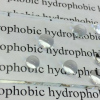Protective and self-cleaning glass coating
Technology description
| The name of the technology: | Protective and self-cleaning glass coating |
|---|---|
| Challenge: |
The product was developed partly in collaboration with a large manufacturer of products made of glass who was looking for a coating that would improve their products´ lightfastness and polymer coating peeling and which would have better resistance against adverse weather conditions. This manufacturer is now interested in the product. Building on a long history of Department of Glass and Ceramics (founded in 1909) in developing know-how in sol-gel coatings, the university has developed an organosilicon solution that ticked all the boxes. The results were confirmed by independent certification company for glass testing. It also proved to be better than competing solutions tested in the University of Chemistry and Technology. |
| Description: |
A glass coating that shows excellent protective and self-cleaning properties, it allows for an easy application on glass surface without the need to use high temperatures or UV for curing and it has a high surface adhesion. The coating is made from one-component material and after easy application via Advantages: - Faster and less frequent glass cleaning compared to cleaning untreated surfaces which is reached primarily due to high hydrophobicity ( water drops contact angle on horizontal surface reaches nearly maximal levels that are possible for flat unstructured surface 110° as opposed to theoretical level of 120°). For comparison, the contact angle of untreated surface is around 20°. - Low technological requirements for application on glass as the coating is ready-to-apply already after one step preparation process via injection, immersion or by coating and with no need of additional heat treatment; - Excellent potential for durability - good chemical resistance and resistance against adverse weather conditions proved by the following model tests - ČSN EN ISO 10545-12 Determination of frost resistance (visual assessment under microscope – without signs of damage), ČSN EN 1096-2 Glass in building - coated glass - requirements and tests methods for class A, B and S (assessment visual with microscope and spectroscopic – without changes in composition, colour and without corosion as opposed to test samples without the coating), ASTMD3363-00 - Film hardness by Pencil test results – best possible results reached in Gouge Hardness 5H and very good result reached in a Scratch Hardness 3H); - highly adhesive due to strong chemical link between the coating and the glass surface (according to the International Standard – ASTM D3359-B – crosscut tape test – score 5B – best possible result); - minimum investment requirements required for mass production - does NOT require REACH registration |
| Commercial opportunity: |
The coating can be applied to glass suited for both interiors and exteriors. The self-cleaning property comes from its hydrophobic and oleophobic surface. The idea is that glass products covered with this coating will generate financial savings due to reduced need to clean such surface and to use cleaning products. The application of such coating can be useful for example for larger glass constructions where an emphasis on clean glass is high and thus there is a potential for maintenance costs savings. Its protective properties are useful for applications on glass in environments with abrasive whether conditions and for glass products of high value. For any potential manufacturer that has experience working with teos of high purity there are minimal investment costs bringing the product on the market. The product does NOT require REACH registration. Cost-wise it is expected that the product is comparable to what is already on the market. |
| IP protection status: | Know-how |
| Development status: |
Phase 4Corresponds with TRL 7 and TRL 8 The transition from the prototype to the final and fully functional form. At this stage, the prototype is already fully tested, or the technology is certified and ready for mass deployment.
|
| Partnering strategy: | licensing |
| More information: | We are looking for a company that can make and distribute chemicals and that is willing to designate time to selling our coating. |
| Images: | |
| Categories: | Chemistry |
| Institution: | University of Chemistry and Technology Prague |
| Owner of a technology: | University of Chemistry and Technology in Prague |
